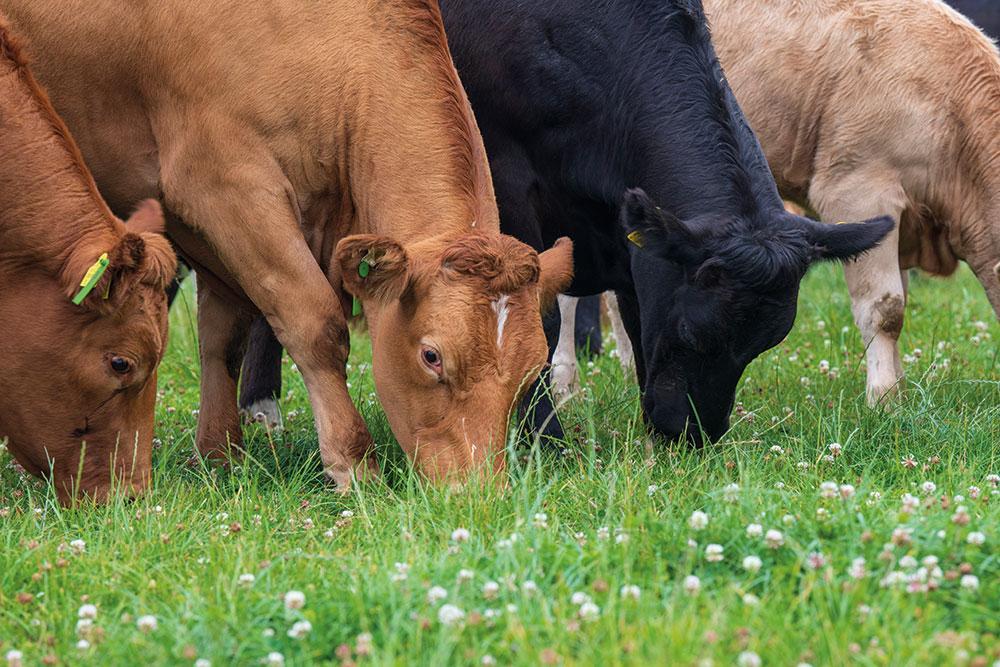21 August 2024
Steady diet of data
Feed-Omics, a collaborative project between Teagasc, University College Dublin and CSIRO in Australia, aims to provide new insights into the molecular regulation of feed efficiency in beef cattle, using state-of-the-art analyses based on systems biology.

Photo credit: Andrew Downes
There is increasing pressure on the global agri-food industry to reduce its environmental footprint, while simultaneously meeting the growing demand for animal protein. Feed accounts for up to 75% of the variable costs in beef cattle production systems; consequently, feed provision is a major determinant of overall profitability and economic sustainability of the enterprise.
There is considerable inter-animal variation for feed efficiency, as defined by residual feed intake (RFI). Feed-efficient cattle are more economical to produce as these animals inherently consume less feed than is expected based on their predicted dietary requirements for maintenance and growth. Additionally, feed-efficient cattle will also contribute to the environmental sustainability of beef production, as these animals typically produce less methane.
Trait complexity
Kate Keogh, a Research Leaders Fellow at Teagasc Grange, explains that identifying and subsequently breeding feed-efficient cattle using genomic selection technology provides an approach through which feed input costs and the environmental footprint of beef production may be reduced.
“However, despite much international research efforts in recent decades, there is still a dearth of knowledge on the underlying biological mechanisms regulating feed efficiency in beef cattle. This is undoubtedly due to the complexity of the trait and the heterogenous nature, in terms of animals and diets employed, of many published studies.”
For example, differences in animal breed, developmental stage and diet, which ultimately confound interpretation of results, have led to inconsistency between experiments.
Moreover, Kate adds: “The potential for a genotype × environment interaction, manifested as the inconsistent ranking of animals for feed efficiency and growth-related traits across contrasting diet types, is an additional concern. This is particularly apparent for grass-based beef production systems, such as that practised in Ireland and in many temperate regions throughout the world.”
The Feed-Omics project, in collaboration with CSIRO in Brisbane, Australia, and The Insight Centre at UCD, aims to bridge this gap. By harnessing data from a number of recent large experiments conducted in Teagasc, it uses advanced systems biology and machine learning analyses to examine the interaction between the effects of genotype (breed) and environment (diet composition) on feed efficiency phenotype.
Gene co-expression
This study used data from the Department of Agriculture, Food and the Marine-funded IDENTIFEED project, which examined the repeatability of feed efficiency in beef cattle.
Kate explains further: “Gene co-expression network analyses were applied to transcriptomic datasets from contrasting breeds of beef cattle, Charolais and Holstein-Friesian steers. These were designated, within breed, as either feed-efficient (Low-RFI; consumed less feed than expected) or feed-inefficient (High-RFI; consumed more feed than expected), following separate contrasting dietary phases (zero-grazed grass and high-concentrate ration).”
Gene co-expression network analysis is based on determining the interaction between genes, such that a change in the expression of one gene may be propagated through interactions and affect the expression of other genes.
Such analyses may also provide more in-depth information on the underlying complex molecular regulation of the trait, which may not be detectable through traditional analyses, says Kate.
“To-date, our analyses have identified biological processes – such as lipid metabolism and immune system function – that are contributing to feed efficiency in beef cattle, irrespective of breed or prevailing diet type. Additionally, our study highlights a potential central role for the NR1H3 gene in regulating feed efficiency of beef cattle, irrespective of the breed or diet offered. Indeed, the NR1H3 gene encodes a protein secreted into the plasma from the liver tissue, providing the possibility for this gene to be explored as a robust biomarker for feed efficiency in beef cattle.”
Rumen microbiome
The community of microorganisms, or microbiome, residing in the rumen dictates the feed degradation capacity and subsequent nutrient supply to the ruminant animal, and is thus a potential contributor to inter-animal variation in feed efficiency. However, the relationship between rumen microbiota and feed efficiency phenotype is not well understood, Kate concludes.
“We aimed to decipher this relationship by applying systems network analysis to rumen microbiome data from selected animals in the IDENTIFEED project. This analysis revealed the Pyramidobacter bacterial genus as the most commonly represented microbe associated with feed efficiency across the contrasting breeds and diets examined; however, no single microbe was related to feed efficiency across all breeds and diets evaluated.”
Ongoing work in this project will further test and validate the results generated thus far for their potential use as biomarkers for the genomic selection of feed efficient beef cattle.
Funding
The Feed-Omics project is funded by the Research Leaders 2025 postdoctoral programme, co-funded by Teagasc and the European Union’s Horizon 2020 research and innovation programme under the Marie Skłodowska-Curie grant agreement number 754380.
Contributors
Kate Keogh, Marie Skłodowska-Curie Fellow, Research Leaders 2025 Fellow, Animal & Grassland Research and Innovation Centre, Teagasc Grange.
kate.a.keogh@teagasc.ie
Toni Reverter, Principal Research Scientist CSIRO, Agriculture & Food, Brisbane, Australia.
Mark McGee, Principal Research Officer, Animal & Grassland Research and Innovation Centre, Teagasc Grange.
David Kenny, Principal Research Officer, Animal & Grassland Research and Innovation Centre, Teagasc Grange.
